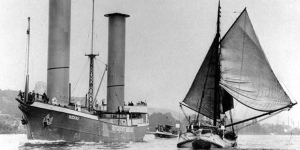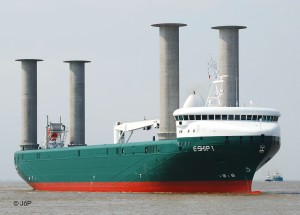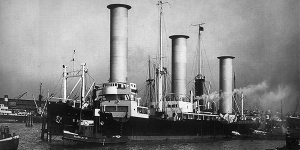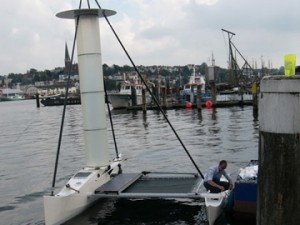History & Validation RFR
 |
History of windpowerAnton Flettner’s spinning bodies were vertical cylinders; the basic idea was to use the Magnus effect. The idea worked, producing the lift and propulsion force needed to replace the old sailing Rig as predicted. These types of propulsion cylinders are now commonly called Flettner rotors. |
Assisted by Albert Betz, Jacob Ackeret, Ludwig Prandtl and Albert Einstein, Flettner constructed an experimental rotor vessel, and in October 1924 the Germania werft finished construction of a large two-rotor ship named Buckau.
The vessel was a refitted schooner which carried two cylinders (or rotors) about 15 metres (50 ft) high, and 3 metres in diameter, driven by an electric propulsion system of 50 hp (37 kW) power. Following completion of its trials, the Buckau set out on her first voyage in February 1925, from Danzig to Scotland across the North Sea. The rotors did not give the slightest cause for concern in even the stormiest weather, and the Flettner rotor vessel could tack (sail into the wind) at 20-30 degrees, while the vessel with its original sail rig could not tack closer than 45 degrees to the wind. On 31 March 1926, the Buckau, now renamed Baden-Baden after the German spa town, sailed to New York via South America, arriving in New York harbor on 9 May.
for demonstration purposes. Fuel was so cheap at that point that the savings achieved by the rotor were too small for shipping companies to recoup the investment quickly enough. Flettner’s attempt to enthuse yachtsmen and women for his rotor fared no better.
In the aftermath of the Great Crash of 1929 and the slump in world trade that followed, the charter operator handed the BARBARA back to its owner, the German Navy, in 1931. The Navy in turn sold the ship on to a new owner who dismantled its three rotors and used only its engines. The history of the rotor ship had come to an end for the moment.
 |
Flettner rotor ship recent Developments – E Ship 1
The German wind-turbine manufacturer Enercon launched and christened its new rotor ship E Ship 1 on the 2nd of August 2008. The vessel has now been in service for 5 years to transport wind turbines and other equipment to locations around the world, which can been see in the movie above. * Picture E Ship 1 curtsy: Jörn Prestien
The University of Flensburg has developed the Flensburg catamaran or Flensburg university Flettner rotor Uni-cat, a rotor-driven catamaran.
Picture showing the Flettner Rotor Credit: Flensburg University

